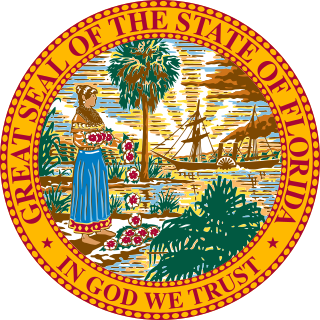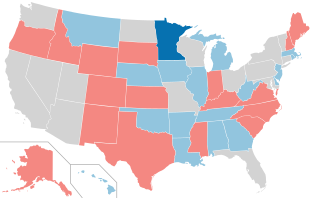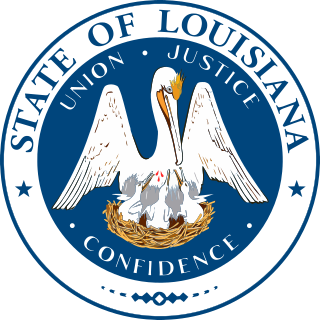Related Research Articles

The Compromise of 1850 was a package of five separate bills passed by the United States Congress in September 1850 that defused a political confrontation between slave and free states on the status of territories acquired in the Mexican–American War. It also set Texas' western and northern borders and included provisions addressing fugitive slaves and the slave trade. The compromise was designed by Whig senator Henry Clay and Democratic senator Stephen A. Douglas, with the support of President Millard Fillmore.

Sodomy laws in the United States, which outlawed a variety of sexual acts, were inherited from colonial laws in the 17th century. While they often targeted sexual acts between persons of the same sex, many statutes employed definitions broad enough to outlaw certain sexual acts between persons of different sexes, in some cases even including acts between married persons.

The New York State Legislature consists of the two houses that act as the state legislature of the U.S. state of New York: The New York State Senate and the New York State Assembly. The Constitution of New York does not designate an official term for the two houses together; it says only that the state's legislative power "shall be vested in the senate and assembly". Session laws passed by the Legislature are published in the official Laws of New York. Permanent New York laws of a general nature are codified in the Consolidated Laws of New York. As of January 2021, the Democratic Party holds supermajorities in both houses of the New York State Legislature, which is the highest paid state legislature in the country.

The Florida Legislature is the legislature of the U.S. State of Florida. It is organized as a bicameral body composed of an upper chamber, the Senate, and a lower chamber, the House of Representatives. Article III, Section 1 of the Florida Constitution, adopted in 1968, defines the role of the legislature and how it is to be constituted. The legislature is composed of 160 state legislators. The primary purpose of the legislature is to enact new laws and amend or repeal existing laws. It meets in the Florida State Capitol building in Tallahassee.
In the United States, state law refers to the law of each separate U.S. state.

The 1990 United States Senate elections were held on Tuesday, November 6, 1990. The Democratic Party increased its majority with a net gain of one seat from the Republican Party. The election took place in the middle of President George H. W. Bush's term, and, as with most other midterm elections, the party not holding the presidency gained seats in Congress.

The Uniform Law Commission (ULC), also called the National Conference of Commissioners on Uniform State Laws, is a non-profit, American unincorporated association. Established in 1892, the ULC aims to provide U.S. states with well-researched and drafted model acts to bring clarity and stability to critical areas of statutory law across jurisdictions. The ULC promotes enactment of uniform acts in areas of state law where uniformity is desirable and practical. The ULC headquarters are in Chicago, Illinois.
An omnibus bill is a proposed law that covers a number of diverse or unrelated topics. Omnibus is derived from Latin and means "to, for, by, with or from everything". An omnibus bill is a single document that is accepted in a single vote by a legislature but packages together several measures into one or combines diverse subjects.

David Dudley Field II was an American lawyer and law reformer who made major contributions to the development of American civil procedure. His greatest accomplishment was engineering the move away from common law pleading towards code pleading, which culminated in the enactment of the Field Code in 1850 by the state of New York.

The Florida Senate is the upper house of the Florida Legislature, the state legislature of the U.S. state of Florida, the Florida House of Representatives being the lower house. Article III, Section 1 of the Constitution of Florida, adopted in 1968, defines the role of the Legislature and how it is to be constituted. The Senate is composed of 40 members, each elected from a single-member district with a population of approximately 540,000 residents. Legislative districts are drawn on the basis of population figures, provided by the federal decennial census. Senators' terms begin immediately upon their election. The Senate Chamber is located in the State Capitol building.

The Louisiana Constitution is legally named the Constitution of the State of Louisiana and commonly called the Louisiana Constitution of 1974, and the Constitution of 1974. The constitution is the cornerstone of the law of Louisiana ensuring the rights of individuals, describing the distribution and power of state officials and local government, establishes the state and city civil service systems, creates and defines the operation of a state lottery, and the manner of revising the constitution.
A rape shield law is a law that limits the ability to introduce evidence or cross-examine rape complainants about their past sexual behaviour. The term also refers to a law that prohibits the publication of the identity of an alleged rape victim.

Law in the state of Louisiana is based on a more diverse set of sources than the laws of the other 49 states of the United States. Private law—that is, substantive law between private sector parties, principally contracts and torts—has a civil law character, based on French and Spanish codes and ultimately Roman law, with some common law influences. Louisiana's criminal law largely rests on American common law. Louisiana's administrative law is generally similar to the administrative law of the federal government and other states. Louisiana's procedural law is generally in line with that of other U.S. states, which in turn is generally based on the U.S. Federal Rules of Civil Procedure.
The Louisiana Civil Code (LCC) constitutes the core of private law in the State of Louisiana. The Louisiana Civil Code is based on a more diverse set of sources than the laws of the other 49 states of the United States: substantive law between private sector parties has a civil law character, based on French and Spanish codes and ultimately Roman law, with some common law influences.

The California Codes are 29 legal codes enacted by the California State Legislature, which together form the general statutory law of California. The official Codes are maintained by the California Office of Legislative Counsel for the Legislature. The Legislative Counsel also publishes the official text of the Codes publicly at leginfo.legislature.ca.gov.

The law of California consists of several levels, including constitutional, statutory, and regulatory law, as well as case law. The California Codes form the general statutory law, and most state agency regulations are available in the California Code of Regulations.

The Republican Party of Louisiana is the affiliate of the Republican Party in the U.S. state of Louisiana. Its chair is Louis Gurvich, who was elected in 2018. It is currently the dominant party in the state, controlling all but one of Louisiana's six U.S. House seats, both U.S. Senate seats, and both houses of the state legislature. The only statewide office that the party does not control is the governorship, which is currently held by Democrat John Bel Edwards.

The Annotated Code of Maryland, published by The Michie Company, is the official codification of the statutory laws of Maryland. It is organized into 36 named articles. The previous code, organized into numbered articles, has been repealed.

The 1825/1826 United States Senate election in New York was held on February 1, 1825, and January 14, 1826, by the New York State Legislature to elect a U.S. Senator to represent the State of New York in the United States Senate.
The law of Texas is derived from the Constitution of Texas and consists of several levels, including constitutional, statutory, and regulatory law, as well as case law and local laws and regulations.
References
- Code of Evidence
- Louisiana Code of Evidence Practice Guide. Third Edition. Michie. 2005. ISBN 9780820574806.
- West's Louisiana Code of Evidence Annotated
- Force and Rault. Handbook on Louisiana Evidence Law. 2014 edition. Thomson West. ISBN 9780314624628.
- Rault Jr., Garard A. (January 1989). "An Overview of the New Louisiana Code of Evidence—Its Imperfections and Uncertainties". Louisiana Law Review . 49 (3).
- Pugh, George W.; Force, Robert; Rault Jr., Gerard A.; Triche, Kerry J. (January 1989). "The Louisiana Code of Evidence—A Retrospective and Prospective View". Louisiana Law Review . 49 (3).
- ↑ The citation of this Code by this title is authorised by article 1102 of this Code.
- ↑ Act 515 of 1988, section 12(3). Digitised copy.
- ↑ Louisiana Code of Evidence, article 101
- ↑ Force, Pugh, Rault and Triche, "Louisiana Code of Evidence - A Retrospective and Prospective View" (1989) 49 La. L. Rev. 689
- ↑ Hargrave, W. Lee (2004). LSU Law: The Louisiana State University Law School from 1906 to 1977. Law school history. Louisiana State University Press. p. 4. ISBN 9780807129142 . Retrieved January 21, 2015.
- ↑ Moore, Elon H. (1928). "Journal of Criminal Law and Criminology: Livingston Code, The". Northwestern University School of Law Scholarly Commons. Retrieved December 29, 2014.
- ↑ Rault Jr., Gerard A. (January 1989). "An Overview of the New Louisiana Code of Evidence - Its Imperfections and Uncertainties". Legal. Louisiana Law Review. pp. 698, volume 49, number 3. Retrieved January 20, 2015.
- ↑ La. H.R. Con. Res. 250, Reg. Sess. (1979) by Representative Ben Bagert
- ↑ Senate Bill by Senator Bagert was rejected.